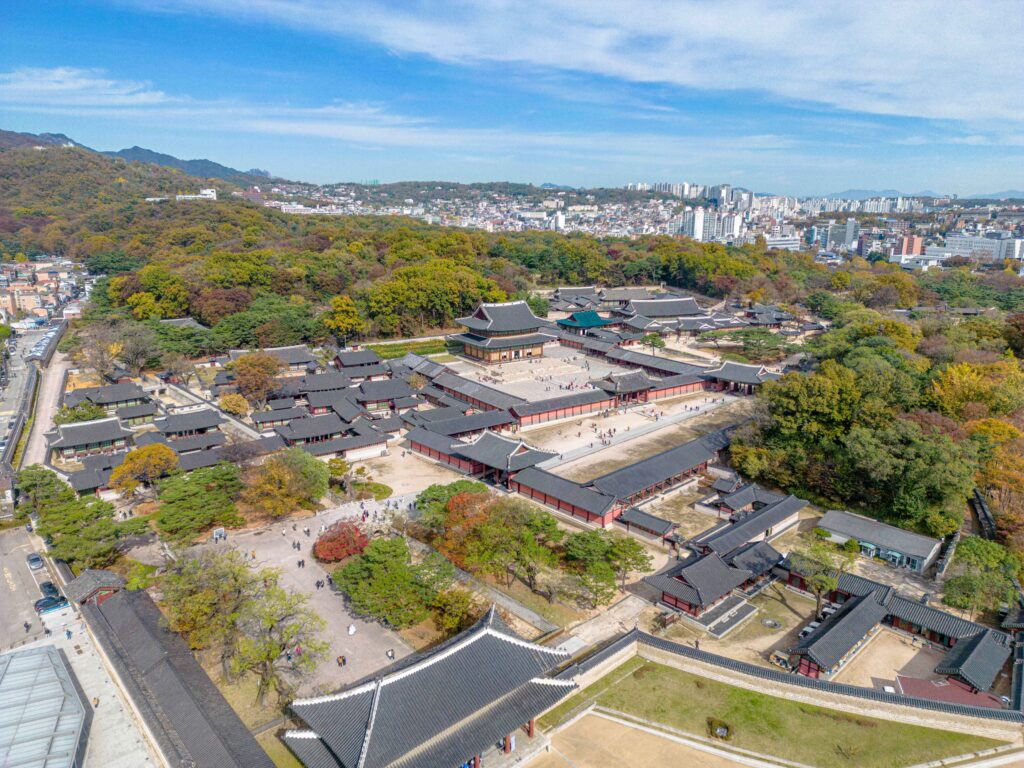‘The Five Royal Palaces in Seoul‘ refer to the palaces used by the kings of the Joseon Dynasty, which have been preserved to this day: Gyeongbokgung, Changdeokgung, Changgyeonggung, Deoksugung, and Gyeonghuigung. It is said that Seoul is the only city where five royal palaces are well-preserved in one location. The Joseon Dynasty was a monarchy that ruled the Korean Peninsula for 518 years, from 1392 to 1910, before the emergence of a modern state. During this time, 27 kings reigned, and Seoul served as the capital.
Access by subway
ⓐ : Gyeongbokgung: Line 3 Gyeongbokgung Palace
ⓑ, ⓒ : Changdeokgung, Changgyeonggung: Line 3 Anguk (Hyundai E & C)
ⓓ : Deoksugung: Line 1 or 2 City Hall
ⓔ : Gyeonghuigung: Line 5 Seodaemun (Kangbuk Samsung Hospital)
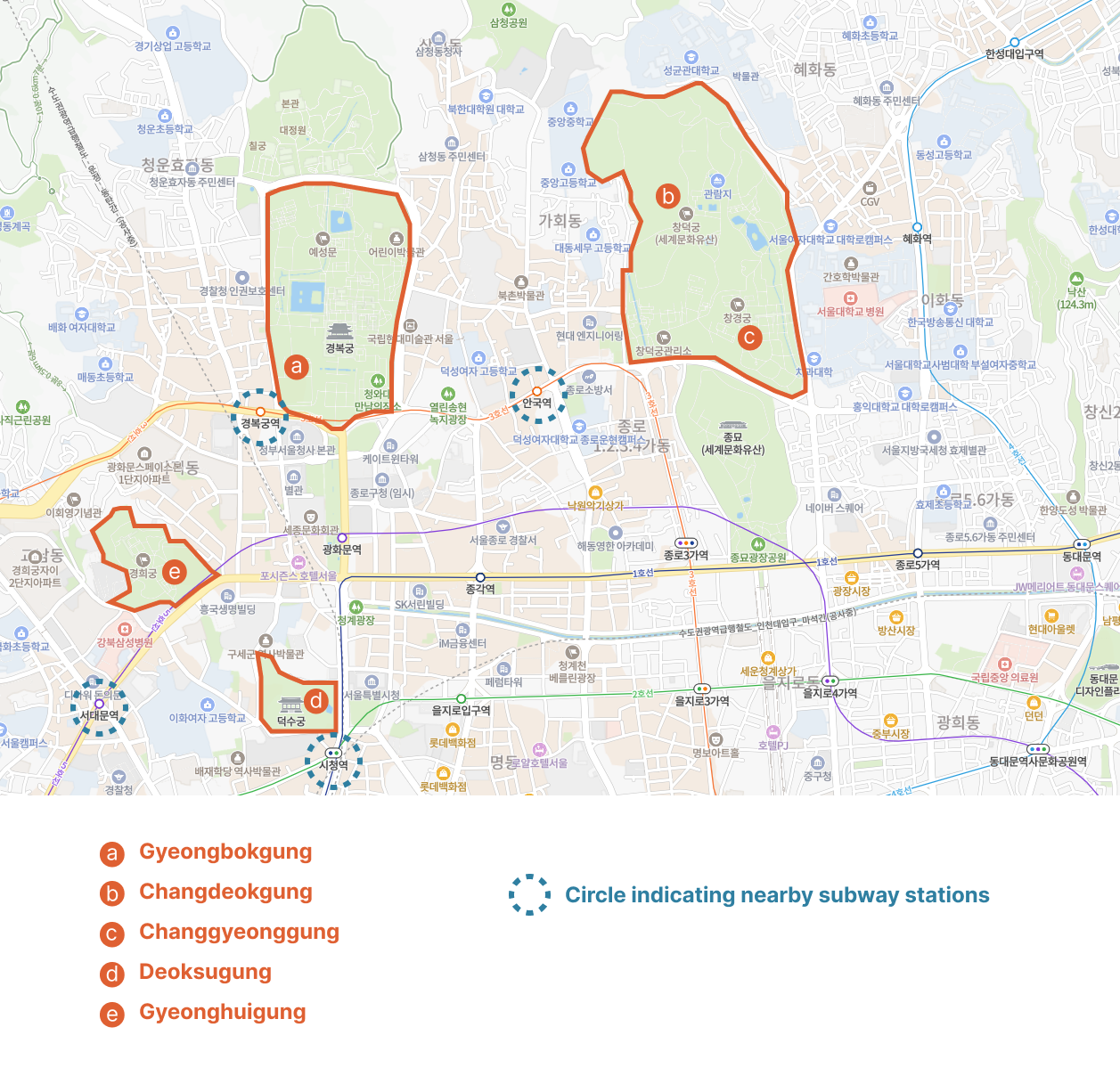
They were constructed in the order of ⓐ to ⓔ.
The Meaning of Visiting Seoul’s Palaces
A palace is a place where kings once strolled in ancient times. As you walk through it, imagine what the king might have thought and what sights might have caught his eye. Try to step into his shoes and follow his thoughts. Since a palace was a stage for intricate political schemes and power struggles surrounding the king, it is one of the best places to experience ‘becoming someone else for a moment.’
It can also be fascinating to observe how the layout and appearance of the buildings differ from what we experience in modern times. The background behind the palace’s construction likely influenced its design and appearance, so it’s worth learning about this history before your visit.
Establishment of the Joseon Dynasty in 1392
In 1392, the Joseon Dynasty was founded, and in 1394, the capital was moved to Hanyang (the former name of Seoul).
Completion of Gyeongbokgung Palace in 1395
The new capital, Hanyang, required a palace. Thus, Gyeongbokgung Palace was completed in 1395.
Gyeongbokgung Palace is the highest-ranking palace of the Joseon Dynasty, built to represent the founding ideals of the nation and to display the power and dignity of the dynasty’s ruler both domestically and internationally. It aimed to strictly adhere to Confucian principles of palace architecture and to serve as a model for palaces in East Asia. Symbolic elements reminding the king of his authority and duties are embedded throughout the palace, which may have created a somewhat psychologically burdensome atmosphere for the monarch. It was the main stage for bloody conflicts over the succession to the throne among the princes and founding contributors following King Taejo, the first monarch of the Joseon Dynasty.
Most kings preferred Changdeokgung Palace over Gyeongbokgung Palace. However, King Sejong, who created the Korean script, Hangul, spent the latter part of his reign at Gyeongbokgung Palace, making him the monarch who used the palace the longest.
-
Related post
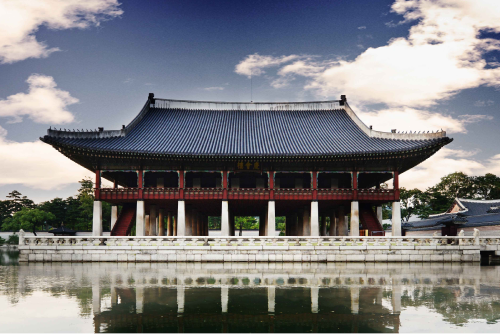
Gyeongbokgung Palace
A representative cultural heritage site in Korea most visited by foreigners, the royal office of a king who ruled in ancient times, and a hub where the past and present of Seoul coexist as a center of social, cultural, and artistic activities. Access by subway Line 3 Gyeongbokgung Palace station Information This cultural heritage of […]
Completion of Changdeokgung Palace in 1395
Changdeokgung Palace is a natural, comfortable, and beautiful palace built by Joseon’s third king, who disliked Gyeongbokgung Palace. It is the only one among the Five Royal Palaces to be designated as a UNESCO World Heritage Site. Changdeokgung Palace served as the royal residence for the longest period in Joseon’s 500-year history. It was built along the slopes of the surrounding mountains, harmonizing with the natural terrain.
Unlike other palaces, which were often constructed to emphasize authority and grandeur through rigid layouts, Changdeokgung Palace was designed to function organically, adapting to the contours of the mountain.
King Taejong, the fifth son of King Taejo, the first monarch of the Joseon Dynasty, secured the throne after a bloody struggle for succession and became Joseon’s third king. However, Taejong disliked Gyeongbokgung Palace, the symbol of Joseon, because it was the site where he had to kill his half-brothers to ascend to the throne. Additionally, it was built under the leadership of Jeong Do-jeon, his political rival. For these reasons, Taejong commissioned the construction of Changdeokgung Palace.
The preference for Changdeokgung Palace among the kings is believed to stem from its structure, location, and aesthetic appeal, which made it more suitable as a royal residence compared to Gyeongbokgung Palace. Visitors who see both palaces often find Changdeokgung Palace’s greenery and natural surroundings more appealing for living. During the Joseon era, Gyeongbokgung Palace lacked the trees and greenery it has today. Instead, its interior was covered with white sand or stone slabs, and the buildings were densely packed.
Completion of Changgyeonggung Palace in 1418
The original name of Changgyeonggung Palace was Suganggung. It was constructed by King Taejong (the third king of Joseon) after he abdicated the throne to his son, King Sejong(who created the Korean script, Hangul), intending to reside there himself. Taejong lived in Suganggung for four years until his passing.
In 1483, due to a lack of sufficient residences for the queens dowager, Suganggung underwent significant expansion and was renamed Changgyeonggung Palace. It shares the same space as Changdeokgung Palace, separated only by a wall.
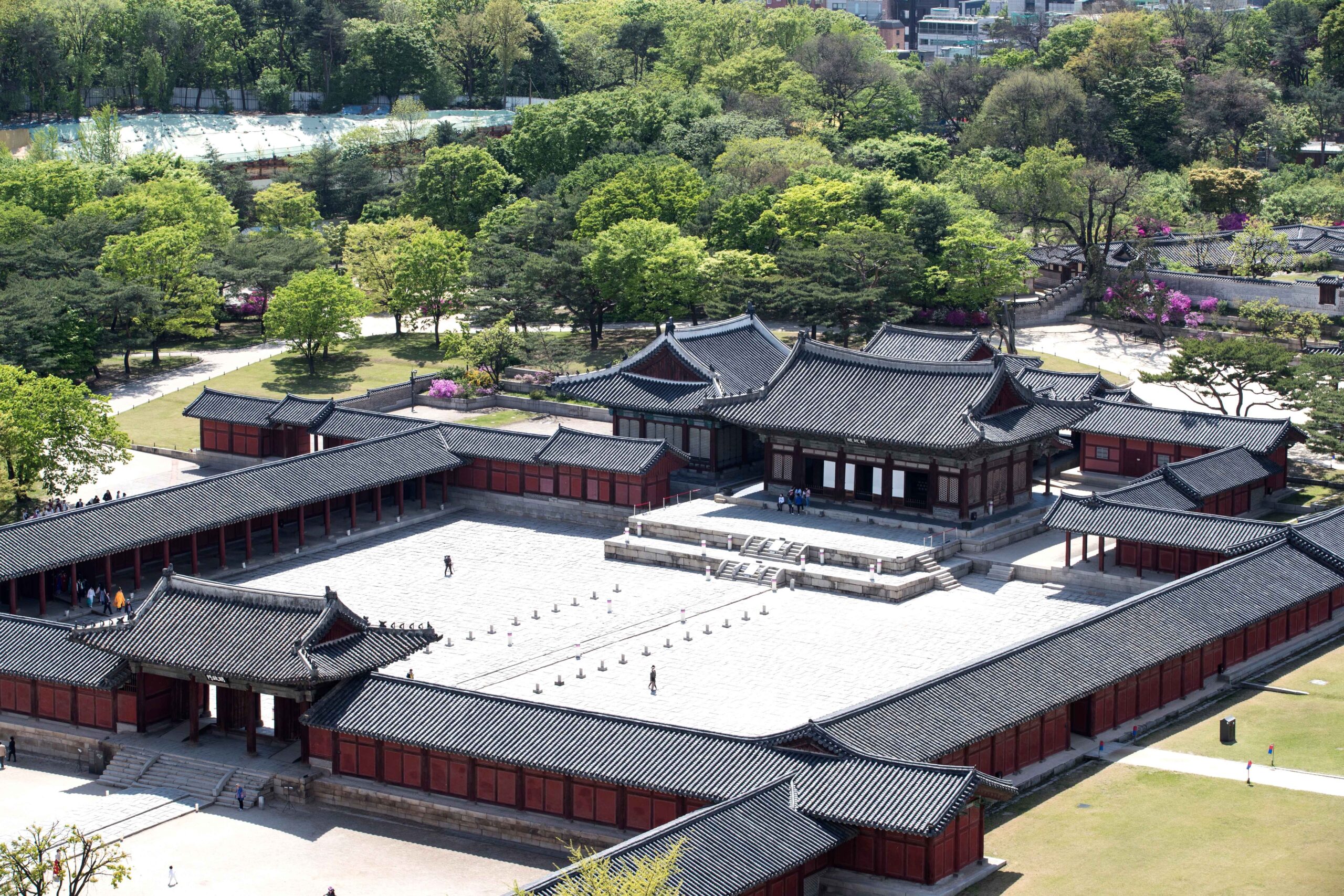
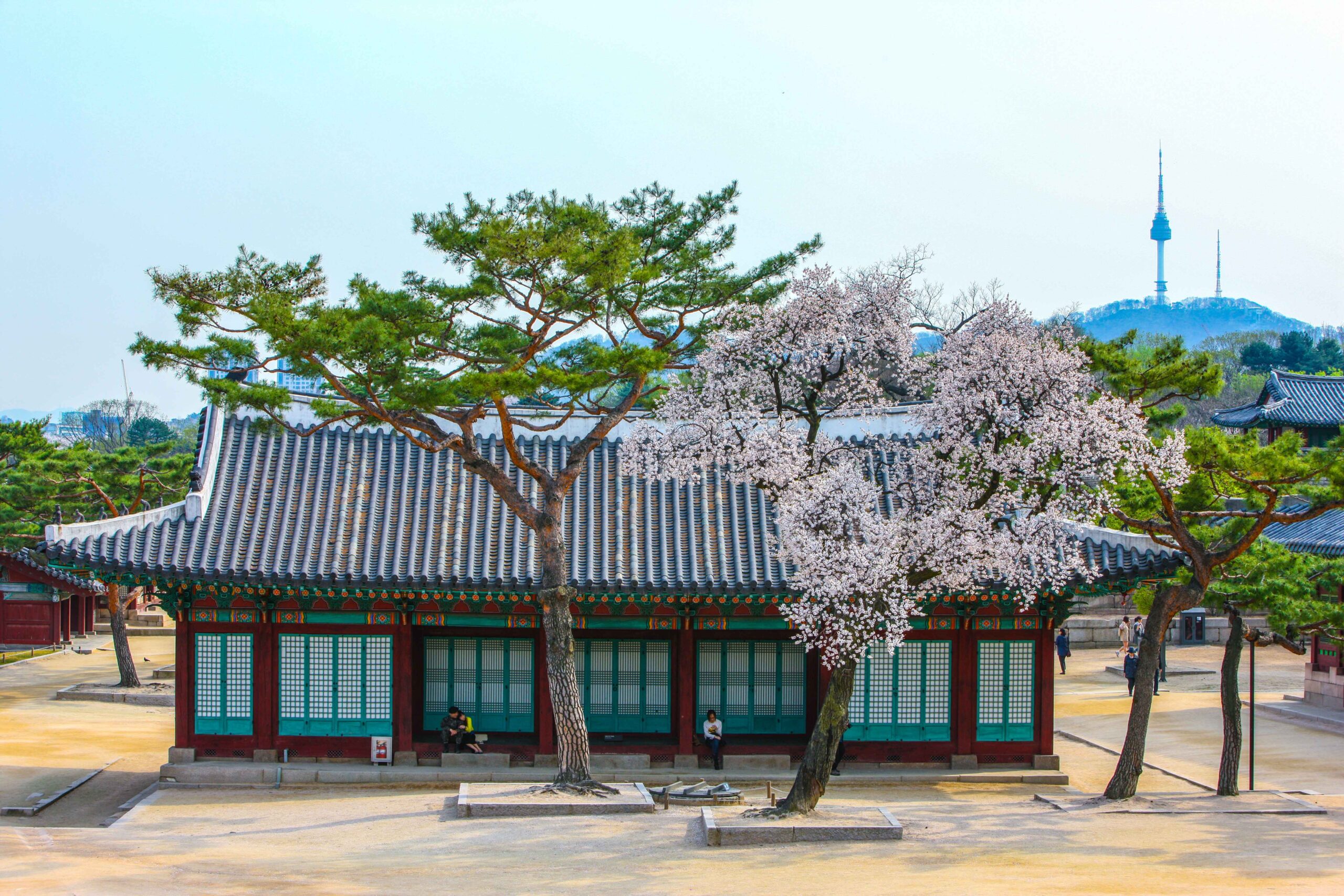
Changgyeonggung Palace © KTO – Lee bumsu, Kim Jiho
Three Palaces Burned Down in 1592
During the seven-year war between Joseon and Japan, triggered by Japan’s invasion, Gyeongbokgung, Changdeokgung, and Changgyeonggung Palaces were all burned down and destroyed.
Deoksugung Palace:
In 1593, an ordinary house was used as the royal palace and only 270 years later was it rebuilt and expanded to serve as a proper palace.
Deoksugung Palace holds a significant amount of painful history.
During and after the seven-year war with Japan, it served as a temporary residence for King Seonjo, the 14th monarch of Joseon. King Gwanghaegun, who succeeded Seonjo, also ascended to the throne in this residence and used it as the royal palace for seven years before relocating to Changdeokgung Palace. When Gwanghaegun moved to Changdeokgung Palace, he named this residence Gyeongungung Palace (‘gyeongun’ means ‘to widely spread happiness). His successor, King Injo (the 16th king), also ascended to the throne in this residence before relocating to Changdeokgung Palace.
Afterward, Gyeongungung Palace spent 270 years without maintaining its status as a proper palace, to the extent that it was not even marked on maps of the late Joseon period.
King Gojong, the 26th monarch of Joseon, resided in the recently reconstructed Gyeongbokgung Palace. After the empress was assassinated by Japanese soldiers there, he sought refuge in the Russian legation. Two years later, in 1897, he moved to Gyeongungung Palace.
Gyeongungung Palace, which had 2-3 buildings, was once again used as the royal palace after 270 years. This was due to its proximity to the legations of Western powers such as Russia, Britain, and the United States, making it easier for the king to request protection in case of an emergency. Lacking the strength to protect himself from the Japanese troops on Korean soil, the king had to stay near the legations of the Western powers.
From that year, the palace underwent large-scale renovations and finally took on the appearance of a proper royal palace. However, Western architectural methods and concrete were heavily used, and some parts were completed during the Japanese occupation. Later, during the Japanese colonial period, the palace grounds were dismantled, and some buildings were demolished.
After King Gojong abdicated in favor of his son, King Sunjong, in 1907, he continued to reside here. The palace was renamed Deoksugung in hopes of wishing for Gojong’s long life.
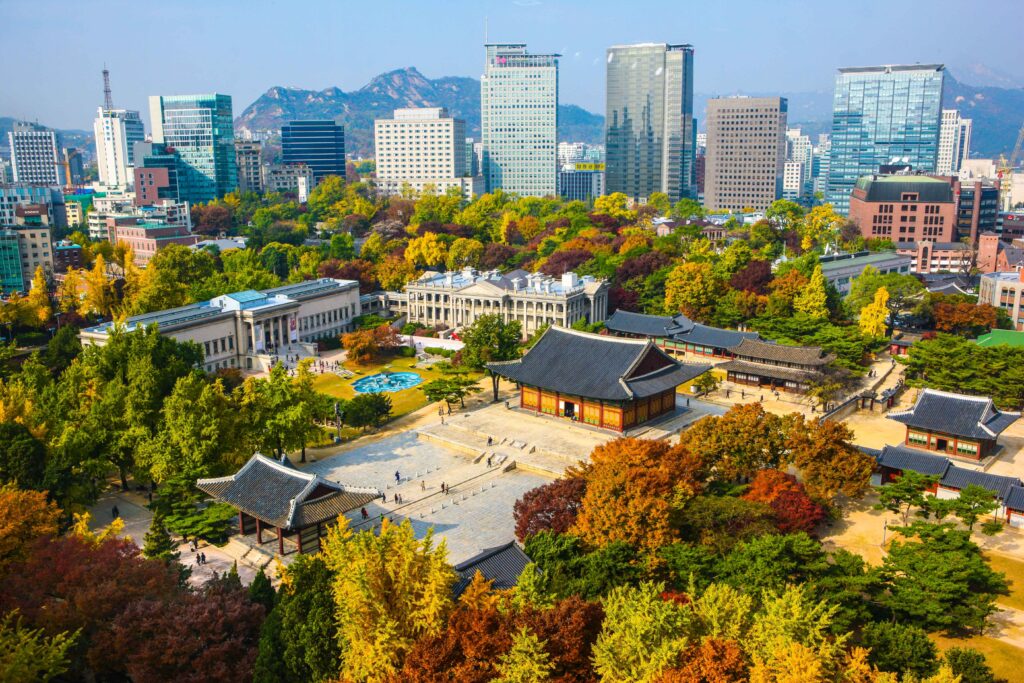
Deoksugung Palace © KTO – Kim Jiho
Completion of Gyeonghuigung Palace in 1620
It is the palace we should feel the most sympathy for and focus on today, as 95% of its original structure has been destroyed as the last palace of the Joseon Dynasty.
Among the three palaces burned down during the seven-year war with Japan —Gyeongbokgung Palace, Changdeokgung Palace, and Changgyeonggung Palace— Changdeokgung Palace was the first to be rebuilt. However, King Seonjo, who endured the war, passed away before its reconstruction was completed. His successor, King Gwanghaegun, ascended to the throne in Seonjo’s temporary residence and moved to Changdeokgung Palace a few years later.
Despite this, King Gwanghaegun disliked living in Changdeokgung Palace, citing unfavorable incidents from the past, such as the deposition of kings who had previously resided there.
Despite urging the reconstruction of Changgyeonggung Palace, the king did not move to Changgyeonggung Palace after its completion.
Because he was not the legitimate heir, the past circumstances in which he would not have ascended to the throne without the war continued to unsettle the king, leading him to avoid the old palaces associated with unfavorable events such as dethronements.
The anxious king focused on eliminating rivals and sought to establish the justification that ‘he had no choice but to become king.’ As part of this effort, he ordered the construction of two new palaces in areas believed to emanate royal energy. These palaces were on a scale comparable to Gyeongbokgung Palace and Changdeokgung Palace, provoking strong opposition from his ministers. Among the two new palaces, only Gyeonghuigung Palace was completed; the other remained unfinished, as the perpetually uneasy king was eventually dethroned.
After the Joseon-Japan Seven-Year War, Gyeonghuigung Palace was used alongside Changdeokgung Palace, with significant usage during the reigns of King Sukjong and King Yeongjo. About 300 years later, during the reconstruction of Gyeongbokgung Palace, many of Gyeonghuigung’s buildings were dismantled to aid in the reconstruction, and during the Japanese colonial period, the remaining structures were also dismantled by the Japanese.
Today, Gyeonghuigung Palace is the least restored to its original form among the five palaces and has the lowest public recognition. However, the Seoul Metropolitan Government has established an extensive restoration plan for Gyeonghuigung Palace and has begun restoration efforts, raising expectations that it will soon regain its former prominence.
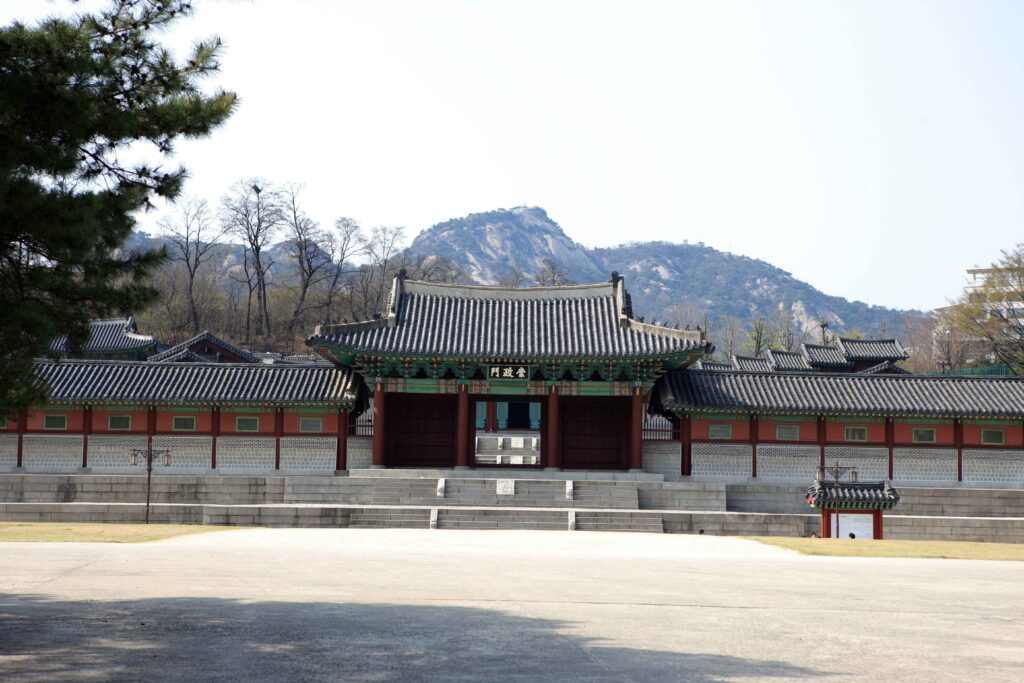
Gyeonghuigung Palace © KTO – Kim Jiho
